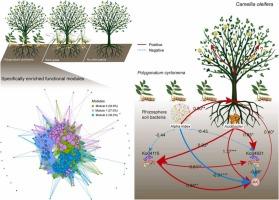Suitable intercropping pattern effectively increases woody oil crop production by enriching soil nutrient-acquiring microbiota
IF 6.2
1区 农林科学
Q1 AGRICULTURAL ENGINEERING
引用次数: 0
Abstract
Intercropping cash crops under Camellia oleifera forests is a strategic measure for enhancing the C. oleifera fruit production and efficiency. Contrary to competing for nutrients, Polygonatum cyrtonema intercropping appears to enhance C. oleifera yield, though the mechanism remains enigmatic. We systematically compared three intercropping patterns—intercropping with P. cyrtonema, prevalent weeds, and monoculture—to examine the effects of these models on soil microbiome and metagenomic profiles, focus on variations in bacterial abundance and functional genes. Additionally, we assessed how changes in bacterial communities influence the growth and yield of C. oleifera. The results showed that the significant enhancement of soil bacterial diversity due to intercropping with P. cyrtonema, notably enriching the Acidibacter, which was linked to improved soil fertility and increased C. oleifera yield. Metagenomic, soil nutrient analysis and laboratory trials suggested that soil organic matter decomposition was accelerated, and specific metabolic pathways (Ko04115 and Ko04931) were significantly enriched after intercropping with P. cyrtonema. Results confirmed the benefits of intercropping with P. cyrtonema for enhancing soil fertility and fruit yield, presenting a sustainable agricultural practice model with broad implications for woody oil crop cultivation and providing a foundation for further optimizing intercropping strategies to maximize benefits for the C. oleifera industry.

适宜的间作模式通过丰富土壤养分微生物群,有效提高木本油料作物产量
油茶林下间作经济作物是提高油茶果实产量和效益的战略措施。与养分竞争相反,黄精间作似乎能提高油葵产量,但其机制尚不清楚。我们系统地比较了三种间作模式——轮作、流行杂草间作和单作间作——以检验这些模式对土壤微生物组和宏基因组图谱的影响,重点关注细菌丰度和功能基因的变化。此外,我们评估了细菌群落的变化如何影响油油树的生长和产量。结果表明,青叶假单胞菌间作可显著提高土壤细菌多样性,其中酸化菌含量显著增加,与土壤肥力的改善和油桐产量的提高有关。宏基因组分析、土壤养分分析和室内试验结果表明,套种后土壤有机质分解加快,特定代谢途径(Ko04115和Ko04931)显著富集。结果证实了油桐间作可提高土壤肥力和果实产量,为油桐木本油料作物种植提供了一种具有广泛意义的可持续农业实践模式,并为进一步优化间作策略以实现油桐产业效益最大化提供了基础。
本文章由计算机程序翻译,如有差异,请以英文原文为准。
求助全文
约1分钟内获得全文
求助全文
来源期刊

Industrial Crops and Products
农林科学-农业工程
CiteScore
9.50
自引率
8.50%
发文量
1518
审稿时长
43 days
期刊介绍:
Industrial Crops and Products is an International Journal publishing academic and industrial research on industrial (defined as non-food/non-feed) crops and products. Papers concern both crop-oriented and bio-based materials from crops-oriented research, and should be of interest to an international audience, hypothesis driven, and where comparisons are made statistics performed.
 求助内容:
求助内容: 应助结果提醒方式:
应助结果提醒方式:


